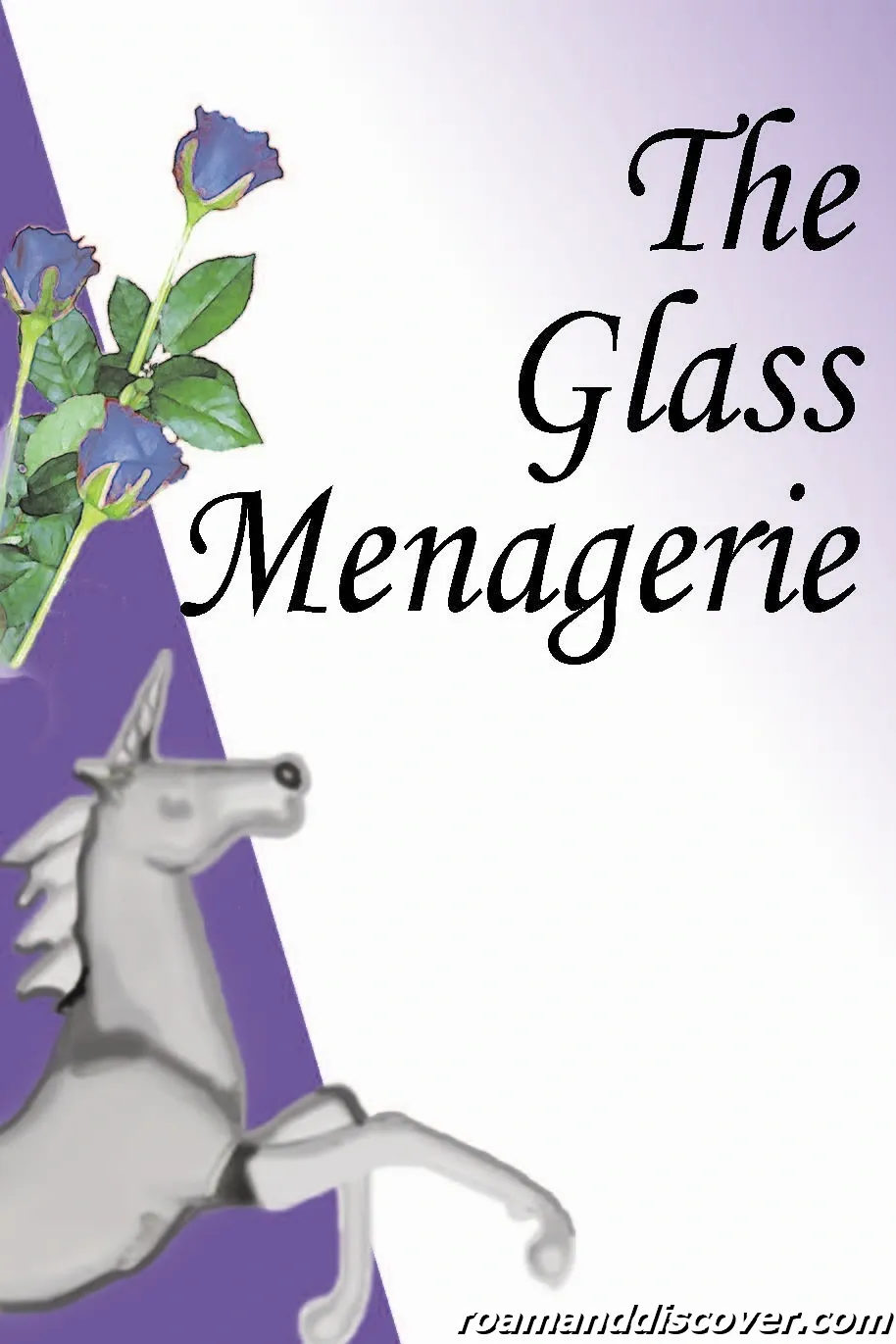Table of Contents
The Glass Menagerie Book Summary
The Glass Menagerie is a classic play written by Tennessee Williams that explores the lives of the Wingfield family in St. Louis during the 1930s. The story revolves around Amanda Wingfield, a faded Southern belle, and her two adult children, Tom and Laura.
The play opens with Tom introducing the audience to his family and their cramped apartment. Amanda is obsessed with finding a suitable suitor for Laura, who is painfully shy and spends most of her time with her collection of glass figurines, known as the glass menagerie. Tom, who works in a warehouse but dreams of escaping his mundane life, serves as the narrator and shares his own frustrations and desires throughout the play.
The plot takes a turn when Tom brings home a gentleman caller, Jim, for Laura. This visit brings both hope and disappointment as Laura’s fragile nature and fear of social interaction become apparent. As the play progresses, the themes of illusion vs. reality, the power of memory, and the destructive nature of dreams become more prominent.
The Glass Menagerie is a deeply symbolic play, with the glass menagerie and the fire escape serving as key symbols. The glass menagerie represents fragility, beauty, and the characters’ desire for escape, while the fire escape symbolizes hope and the characters’ longing for a better life.
The Glass Menagerie is a thought-provoking play that explores family dynamics, the struggles of individuals trapped in their own circumstances, and the power of dreams and illusions. It continues to captivate audiences with its timeless themes and beautifully crafted characters.
Background
The Glass Menagerie is a renowned play written by Tennessee Williams, one of the most influential American playwrights of the 20th century. Born in 1911 in Mississippi, Williams drew inspiration from his own troubled family life and experiences to create this iconic piece of literature. The play was first performed in 1944 and has since become a classic of American theater.
Set in St. Louis during the 1930s, The Glass Menagerie reflects the social and economic struggles of the time, as well as the impact of the Great Depression on ordinary families. Williams’ vivid portrayal of the Wingfield family and their daily lives captures the essence of the era, providing a poignant commentary on the human condition.
Williams’ writing style is characterized by its poetic language and introspective exploration of complex emotions. With The Glass Menagerie, he delves into themes such as memory, illusion, and the pursuit of dreams. The play’s semi-autobiographical nature adds depth and authenticity to the narrative, making it relatable to audiences across generations.
The Glass Menagerie is not only a reflection of the time in which it was written but also a timeless exploration of universal human experiences. Its enduring popularity and numerous adaptations in theater, film, and literature attest to its continued relevance and impact on audiences worldwide.
Characters
The Glass Menagerie introduces readers to a small cast of characters, each with their own unique personalities, relationships, and motivations. These characters bring depth and complexity to the play, capturing the audience’s attention and immersing them in the story.
Amanda Wingfield: As the matriarch of the family, Amanda is a strong-willed and nostalgic woman who often lives in the past. She constantly reminisces about her youth and desperately tries to control the lives of her children, Tom and Laura. Amanda’s motivations stem from her desire to secure a stable future for her family and find a suitable suitor for Laura.
Tom Wingfield: Tom serves as the narrator of the play and is torn between his responsibilities to his family and his longing for freedom. He works in a shoe warehouse to support his mother and sister but yearns for adventure and the chance to pursue his own dreams. Tom’s motivations are driven by his need to escape the suffocating environment of his home and find his own path in life.
Laura Wingfield: Laura is a delicate and shy character who is often overshadowed by her mother’s expectations. She finds solace in her collection of glass figurines, which serve as a metaphor for her own fragile nature. Laura’s motivations stem from her fear of the outside world and her desire to find acceptance and love.
These characters, with their complex relationships and motivations, drive the narrative of The Glass Menagerie, creating a captivating and emotionally charged story that explores themes of family, dreams, and the struggle for individuality.
Amanda Wingfield
Amanda Wingfield is one of the central characters in Tennessee Williams’ play, The Glass Menagerie. As the matriarch of the family, Amanda holds a significant role in the dynamics of the Wingfield household. She is a character who struggles with nostalgia and control, which adds depth to her portrayal.
Amanda is a mother who constantly reminisces about her past and her days as a Southern belle. She often shares stories of her youth and her suitors, living in a world of memories and longing for the glamourous life she once had. This nostalgia becomes a source of tension within the family, as Amanda’s dreams clash with the reality of their present situation.
Amanda’s desire to control her children’s lives stems from a place of love and concern, but it often leads to conflict. She is overprotective of her daughter, Laura, and constantly pushes her to find a suitor and settle down. Amanda’s intentions are rooted in wanting the best for her children, but her methods can be suffocating and restrictive.
In her role as the matriarch, Amanda is a complex character who embodies the struggles of balancing nostalgia and control. Through her portrayal, Tennessee Williams explores themes of family dynamics, the power of memories, and the challenges of letting go of the past.
Tom Wingfield
An analysis of Tom’s character as the narrator and his conflicting desires for freedom and responsibility.
Tom Wingfield is the narrator and one of the main characters in The Glass Menagerie. He is a complex character who is torn between his desire for freedom and his sense of responsibility towards his family. As the play unfolds, we see Tom struggling to balance these conflicting desires, which ultimately leads to his own internal conflict.
Tom is a dreamer and longs for adventure and excitement outside of the confines of his mundane life. He is dissatisfied with his job at a shoe warehouse and yearns for something more meaningful. This desire for freedom is symbolized by his frequent visits to the movies, where he can escape into a world of fantasy and adventure.
However, Tom also feels a strong sense of responsibility towards his mother, Amanda, and his sister, Laura. He feels obligated to provide for them and support them financially. This conflict between his desire for freedom and his responsibility towards his family creates tension within Tom’s character and drives much of the plot.
In addition to his conflicting desires, Tom also serves as the narrator of the play. He speaks directly to the audience and provides insight into the events and characters. Through his narration, we gain a deeper understanding of the play’s themes and the motivations of the other characters.
Tom Wingfield’s character is a complex portrayal of the struggle between freedom and responsibility. His conflicting desires and role as the narrator add depth and complexity to the story, making him a central figure in The Glass Menagerie.
Laura Wingfield
Laura Wingfield is one of the main characters in The Glass Menagerie and plays a crucial role in the development of the play’s themes. She is portrayed as a delicate and fragile young woman who is socially withdrawn and struggles with her own insecurities.
Throughout the play, Laura is often associated with the glass menagerie, a collection of delicate glass figurines that she treasures and cares for. This symbolism reflects Laura’s own fragility and vulnerability. Just like the glass figurines, she is delicate and easily broken.
Laura’s connection to the glass menagerie also highlights her isolation from the outside world. She spends much of her time alone, taking care of her glass collection, which serves as a form of escapism from the harsh realities of life. This isolation further emphasizes her fragile nature and her inability to cope with the challenges of the real world.
Laura’s symbolic connection to the glass menagerie can be seen as a reflection of her own self-image. She sees herself as different from others, just like the unique and fragile glass figurines. This perception of herself as different and fragile contributes to her social anxiety and fear of being judged by others.
Laura Wingfield’s fragile nature and her symbolic connection to the glass menagerie serve as important elements in The Glass Menagerie. Through her character, Tennessee Williams explores themes of fragility, isolation, and the struggle to find one’s place in the world.
Themes
Themes play a significant role in shaping the narrative and underlying messages of a play, and The Glass Menagerie is no exception. Tennessee Williams explores several major themes throughout the play, including illusion vs. reality, the power of memory, and the destructive nature of dreams.
Illusion vs. Reality: One of the central themes in The Glass Menagerie is the contrast between illusion and reality. The characters in the play often create illusions to escape the harsh realities of their lives. Amanda, for example, constantly reminisces about her glamorous past and tries to recreate it in her present circumstances. Tom, the narrator, seeks solace in movies and his own dreams of adventure. Laura, on the other hand, retreats into her collection of glass figurines, finding comfort in their delicate beauty. However, these illusions ultimately prove to be fragile and unsustainable, leading to disappointment and heartbreak.
The Power of Memory: Memory is another prominent theme in the play. Williams explores the ways in which memories shape and influence our lives. The characters in The Glass Menagerie are deeply affected by their memories, which often blur the lines between past and present. Amanda constantly reminisces about her youth and the “gentleman callers” she once had, while Tom is haunted by memories of his father’s abandonment. Memory serves as both a source of comfort and a burden, highlighting the characters’ longing for a time that no longer exists.
The Destructive Nature of Dreams: Dreams and aspirations can be both empowering and destructive, and this theme is explored in The Glass Menagerie. Each character harbors dreams of a better life, but these dreams often clash with their reality. Amanda dreams of finding a suitable husband for Laura, while Tom dreams of escaping his monotonous life and pursuing his own ambitions. However, these dreams ultimately lead to disappointment and disillusionment. The play suggests that dreams, if not grounded in reality, can have destructive consequences.
Through the exploration of these themes, The Glass Menagerie offers a poignant and thought-provoking examination of the human condition. Williams’ masterful use of language and symbolism elevates the play to a timeless piece of literature that continues to resonate with audiences today.
Symbolism
The play The Glass Menagerie by Tennessee Williams is rich in symbolism, using various objects and elements to convey deeper meanings. Symbolism plays a crucial role in enhancing the themes and characters’ struggles in the play.
One of the key symbols in The Glass Menagerie is the glass menagerie itself. It represents fragility, beauty, and the characters’ desire for escape. The glass animals in Laura’s collection mirror her delicate nature and vulnerability. They also symbolize the delicate balance of the Wingfield family and the fragile nature of their dreams. Just like the glass animals, the characters are trapped in their own worlds, longing for something more.
Another significant symbol in the play is the fire escape. It represents hope and the characters’ longing for a better life. The fire escape is the only way out for the characters, symbolizing their desire to escape their current circumstances. However, it also serves as a reminder that their dreams and aspirations may never be fully realized. The fire escape is a constant reminder of the harsh reality they face, while also offering a glimmer of hope for a brighter future.
In addition to these symbols, Williams also uses other objects and elements, such as the music and the photograph of the absent father, to convey deeper meanings and emotions throughout the play. These symbols add depth and complexity to the story, allowing the audience to engage with the characters’ struggles on a deeper level.
the use of symbolism in The Glass Menagerie enhances the themes of illusion vs. reality, the power of memory, and the destructive nature of dreams. It adds layers of meaning to the play, making it a thought-provoking and impactful piece of literature.
The Glass Menagerie
The glass menagerie in Tennessee Williams’ play serves as a powerful symbol that represents several key themes and desires within the story. Firstly, it symbolizes fragility, as the delicate glass figurines mirror the delicate nature of the Wingfield family. Just as the glass menagerie can easily shatter, the characters’ lives are also on the brink of collapse.
Furthermore, the glass menagerie represents beauty. Laura, the daughter of the Wingfield family, is often associated with the glass figurines due to her own fragile and ethereal nature. Like the glass menagerie, she is delicate and beautiful, but also isolated and trapped.
the glass menagerie symbolizes the characters’ desire for escape. Each member of the Wingfield family longs for a better life and dreams of breaking free from their current circumstances. The glass menagerie represents their hopes and aspirations, serving as a reminder of their yearning for a more fulfilling existence.
the glass menagerie in Tennessee Williams’ play is a multi-faceted symbol that embodies fragility, beauty, and the characters’ desire for escape. Through this symbol, Williams effectively explores the themes of vulnerability, longing, and the search for meaning in a world filled with illusions and shattered dreams.
The Fire Escape
The fire escape in The Glass Menagerie serves as a powerful symbol of hope and the characters’ longing for a better life. It represents the possibility of escape from their current circumstances and the pursuit of dreams and aspirations. Throughout the play, the fire escape is depicted as a physical pathway that connects the Wingfield family’s apartment to the outside world. It serves as a means of escape from the suffocating environment of their cramped and stifling apartment. The characters, particularly Tom, view the fire escape as a way to break free from their mundane and unfulfilling lives.For Tom, the fire escape represents his desire for adventure and freedom. He feels trapped in his role as the sole provider for the family and yearns for a more exciting existence. The fire escape offers him a glimmer of hope, a chance to leave behind his responsibilities and pursue his own dreams.Similarly, the fire escape holds significance for Laura. As a shy and introverted character, she finds solace in her collection of glass figurines, her own little world of beauty and fragility. The fire escape represents her longing for connection and escape from her insecurities. It symbolizes her desire to break free from the confines of her own self-doubt and find her place in the world.the fire escape in The Glass Menagerie serves as a powerful symbol of hope and the characters’ yearning for a better life. It represents their aspirations, dreams, and the possibility of a brighter future beyond their current circumstances. It is a reminder that even in the face of adversity, there is always a glimmer of hope and the potential for change.
Frequently Asked Questions
Answers to common questions about The Glass Menagerie:
- Q: What is The Glass Menagerie about?
- A: The Glass Menagerie is a play written by Tennessee Williams that tells the story of the Wingfield family, focusing on the relationships between its members and their struggles with illusion, memory, and dreams.
- Q: Who is the author of The Glass Menagerie?
- A: The Glass Menagerie was written by Tennessee Williams, a renowned American playwright. Williams is known for his poetic and emotionally charged plays that explore the complexities of human relationships.
- Q: What are the major themes in The Glass Menagerie?
- A: The play explores themes such as illusion versus reality, the power of memory, and the destructive nature of dreams. It delves into the characters’ desires for escape and their struggles with the constraints of their own lives.
- Q: What is the symbolism in The Glass Menagerie?
- A: The Glass Menagerie utilizes symbolism to convey deeper meanings. The glass unicorn represents fragility and the characters’ longing for uniqueness. The fire escape symbolizes hope and the characters’ yearning for a better life.
- Q: Is The Glass Menagerie still relevant today?
- A: Yes, The Glass Menagerie continues to be relevant today due to its exploration of universal themes and the complex dynamics within families. Its examination of the human condition and the pursuit of dreams resonates with audiences of all generations.
These are just a few answers to frequently asked questions about The Glass Menagerie. The play’s timeless themes, compelling characters, and powerful symbolism make it a significant work of literature that continues to captivate audiences.



admin
CEO